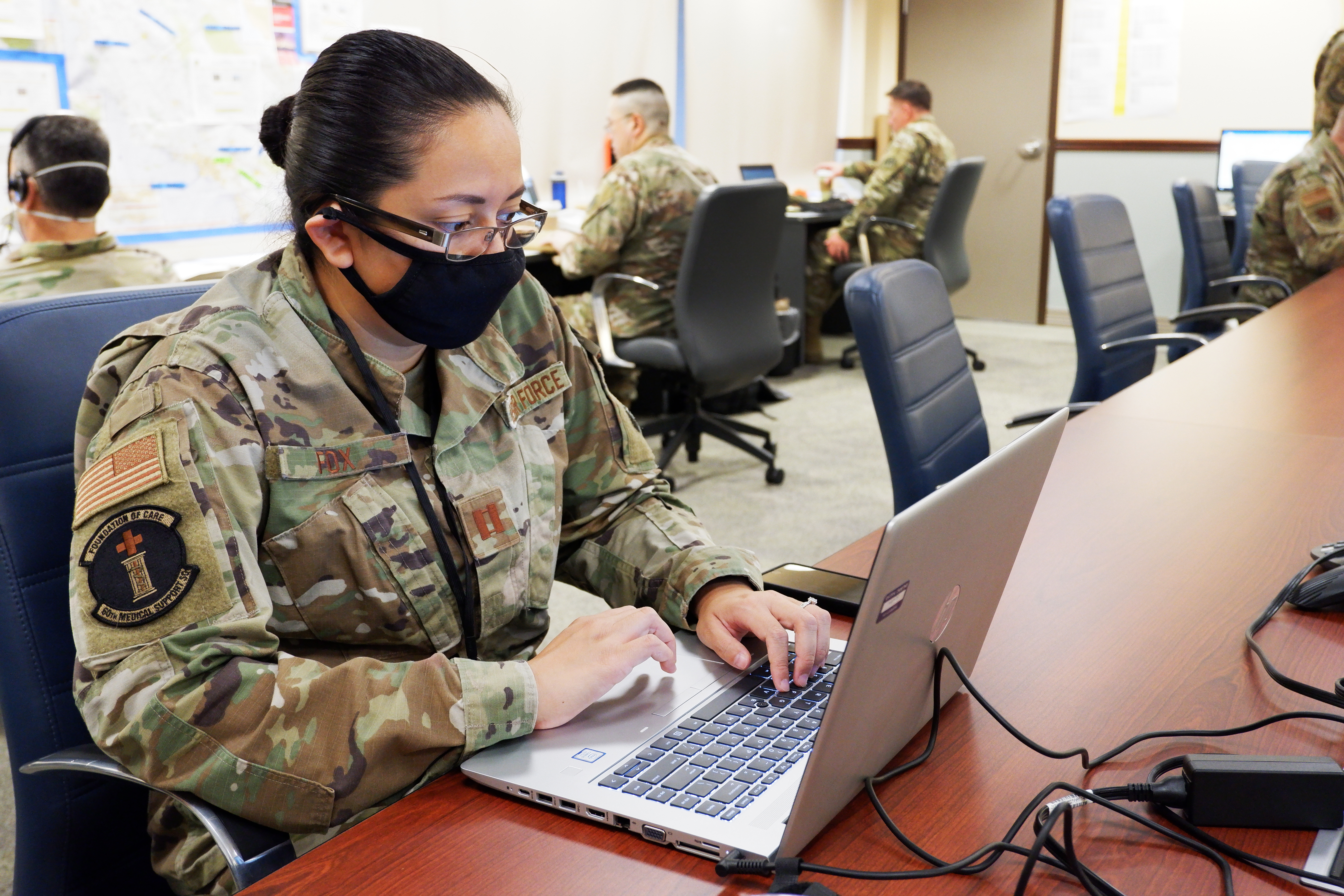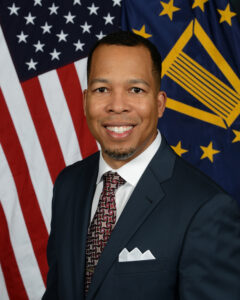
Air Force Capt. Amanda Fox, assigned to COVID Theater Hospital-1, works on a laptop at the David Grant U.S. Air Force Medical Center, Travis AFB.
There’s a defense cloud program that may turn out to be worth even more than the highly publicized $10 billion Joint Enterprise Defense Infrastructure (JEDI) enterprise cloud program. Defense Enclave Services (DES) is a defense cloud-computing contract intended to bring enterprise email, voice, video, and collaboration to the Pentagon’s so-called “Fourth Estate” – the DoD agencies and departments not directly part of the individual military services or intelligence agencies.
Defense Enclave Services is part of the DoD Digital Modernization Strategy — along with the Joint Artificial Intelligence Center and JEDI. Like JEDI, the DES contract calls for a single winner-take-all award, a contract with the potential to last a decade. The Defense Information Systems Agency (DISA) will manage it. DES is designed to consolidate the networks, processes, tools, and infrastructure of 22 disparate DoD organizations, everything from the Office of the Secretary of Defense to such agencies as the Defense Health Agency, the Defense Logistics Agency, and the Missile Defense Agency.
In the interview, Llewellyn “Don” Means, DISA’s Defense Enclave Services Executive, explains the program’s challenges and goals.
BD: What were the “aha” moments when DoD realized it needed to do something about fourth estate network modernization? What prompted this effort?
Don Means: In 2018, the DoD chief management officer and chief information officer established the 4th Estate Network Optimization (4ENO) program as our response to support the reform line of effort in the National Defense Strategy (NDS). The 4ENO program is a bold, aggressive reform designed to implement structural change by creating an IT enterprise that is more modern, more secure, and more capable for 13 Defense Agencies and Field Activities under one single service provider (DISA) in its first phase. Network enclaves will be migrated to a single service provider to manage common shared IT services to Fourth Estate entities, allowing agencies to focus on their core missions.

Llewellyn “Don” Means, DISA’s Defense Enclave Services Executive.
BD: What are the key challenges associated with Fourth Estate network optimization modernization?
Means: There are always challenges working in a resource-constrained environment. One of the goals of network optimization is to consolidate services and find cost savings for the department and ultimately our nation’s warfighters. It is also a challenge to bring infrastructure and security in varying states up to DoD standards. However, the main challenge is that every Defense Agency and Field Activity is important, and we have to enable all of their missions while finding these efficiencies. Our program is mindful of investment where we can maximize return and accomplish the program objectives of efficiency, security, standardization, and mission success.
BD: How are you going about approaching this modernization effort?
Means: DISA is working closely with the DoD CIO and our Fourth Estate mission partners. This collaboration will ensure that we are working in tandem to have consensus on timelines, costs, and the method that service will be provided in the future. Our goal is to standardize architecture and services as much as possible, and normalize processes and procedures across the Fourth Estate. We believe that optimizing these IT processes will be a tremendous value add across the DoD, from the perspectives of cost savings, security, mobility, and modernization.
BD: What do companies need to show you that they can accomplish to execute this modernization effort in the fashion you want it?
Means: Companies will send competitive proposals to be evaluated by DISA’s source selection team. Each proposal should answer the criteria specified in the Defense Enclave Services (DES) Request for Proposal (RFP) that will be released in October or November 2020.
BD: How can agencies deliver innovation with standard applications and tools used in modernization initiatives?
Means: We are actually looking forward to the proposals from industry in response to the DES RFP. We are looking to our private sector partners to generate and identify opportunities for new technology insertion, and to promote innovation. We are committed to provide our Fourth Estate partners, effective, predictable, and reliable service delivery. We are also focused on the automation of processes, tighter policies regarding data retention and storage, and improved end-user support through virtual kiosks, self-help portals and more. We will continue to work to optimize the user experience through innovation.
BD: IT modernization involves more than technology. How do you achieve the behavioral changes and cultural shifts needed for the expected outcomes?
Means: While I agree with you to some extent, I am a strong believer that if you improve the way IT services are delivered then it can change culture all by itself. Look at how culture has changed with collaboration over the last six months during this COVID crisis, simply by delivering the tools and IT. In the end state, with one cohesive DoD Network for the Fourth Estate, one could in theory travel to any Fourth Estate campus and use the network there—just like they would in their primary office. That, in and of itself, could change the way we view a distributed workforce, for example.
It is our goal to provide two-way communication channels where we are communicating early and often about the changes that are coming. We are also working collaboratively with our partners to elicit their feedback and suggestions for future services. We believe this new model will enable agencies to singularly direct their focus on their respective missions, and DISA as the single service provider will optimize their productivity with the necessary IT infrastructure and enterprise services.
BD: What are the latest timeline and key milestones for the program?
Means: The final RFP will be released in October or November 2020, with proposals due soon after. Projected contract award is December 2021.






















